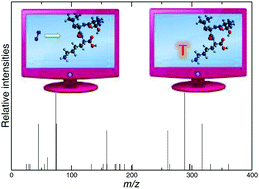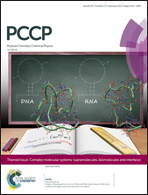Chemical dynamics simulations of CID of peptide ions: comparisons between TIK(H+)2 and TLK(H+)2 fragmentation dynamics, and with thermal simulations†
Abstract
Gas phase unimolecular fragmentation of the two model doubly protonated tripeptides threonine–isoleucine–lysine (TIK) and threonine–leucine–lysine (TLK) is studied using chemical dynamics simulations. Attention is focused on different aspects of collision induced dissociation (CID): fragmentation pathways, energy transfer, theoretical mass spectra, fragmentation mechanisms, and the possibility of distinguishing isoleucine (I) and leucine (L). Furthermore, discussion is given regarding the differences between single collision CID activation, which results from a localized impact between the ions and a colliding molecule N2, and previous thermal activation simulation results; Z. Homayoon, S. Pratihar, E. Dratz, R. Snider, R. Spezia, G. L. Barnes, V. Macaluso, A. Martin-Somer and W. L. Hase, J. Phys. Chem. A, 2016, 120, 8211–8227. Upon thermal activation unimolecular fragmentation is statistical and in accord with RRKM unimolecular rate theory. Simulations show that in collisional activation some non-statistical fragmentation occurs, including shattering, which is not present when the ions dissociate statistically. Products formed by non-statistical shattering mechanisms may be related to characteristic mass spectrometry peaks which distinguish the two isomers I and L.



 Please wait while we load your content...
Please wait while we load your content...